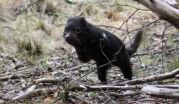(Press-News.org) New research in Respirology shows that suffers of Chronic obstructive pulmonary disease (COPD) can reduce their risk of being hospitalized with severe attacks, by maintaining an exercise regime of walking between three to six kilometers a day.
COPD, a term which includes chronic bronchitis and emphysema, results in breathing difficulties due to long-term lung damage. Severe symptoms (eCOPD), caused by a sudden loss of lung function, can be life threatening.
543 COPD patients were recruited from five Spanish respiratory clinics and their exercise levels were calculated based on the distance they walked during the course of a week. This information was compared to hospitalization data taken from the database of Bilbao's Hospital Galdakao-Usansolo.
The results showed that COPD patients who maintained moderate or high levels of exercise over time, which may amount to low intensity activities such as walking for at least three to six kilometers per day, could reduce the likelihood of being hospitalized by severe symptoms.
In contrast, patients who maintained a low level of exercise or reduced their exercise over time were more likely to experience a significant increase in the rate of hospitalization with exacerbated symptoms.
"COPD patients are less likely to engage in regular physical activity than healthy individuals. However, regular exercise has been associated with reduced risk of hospitalization for exacerbated COPD and mortality among patients with COPD," said Dr. Cristóbal Esteban. "Indeed, even a low level of PA such as walking a minimum of 2 hours per week has been associated with decreased risk of hospitalization for exacerbated COPD."
INFORMATION: END
Daily walk of just 3km can reduce risk of hospitalization for respiratory problems
2014-02-18
ELSE PRESS RELEASES FROM THIS DATE:
Magnesium may protect against hip fractures
2014-02-18
Drinking water with a relatively high concentration of magnesium protects against hip fractures, according to results of a study from the Norwegian Institute of Public Health.
There are considerable variations in the quality of drinking water in Norway. The researchers studied variations in magnesium and calcium levels in drinking water between different areas, as these are assumed to have a role in the development of bone strength. They wanted to examine whether there was a correlation between magnesium and calcium concentrations in drinking water and the incidence ...
Beauty & bacteria: Slim, attractive men have less nasal bacteria than heavy men
2014-02-18
Do attractive traits tell us anything about a person's reproductive health? New research in the American Journal of Human Biology reveals a link between Body Mass Index (BMI) and the amount of bacteria colonizing noses. The results show that heavier men harbor more potentially pathogenic species of bacteria in their nose, compared with slimmer, more traditionally attractive men.
"According to an evolutionary point of view, traits related to attractiveness are supposed to be honest signals of biological quality," said Dr. Boguslaw Pawlowski. "We analyzed whether nasal ...
Malnutrition decreases effectiveness of HIV treatment in pregnant African women
2014-02-18
In Uganda the prescription of three antiretroviral (ARV) drugs, which aim to suppress the virus to prevent disease progression, have resulted in huge reductions in HIV mortality rates. However, disease is not the only scourge in Uganda, and a new study in The Journal of Clinical Pharmacology explores the impact food insecurity may have on treating pregnant women.
A U.S-Ugandan research team explored the affect pregnancy and malnutrition can have on the administration of lopinavir/ritonavir (LPV/r) and efavirenz (EFV) drugs among HIV-infected women in Tororo, Uganda.
Blood ...
Infected Tasmanian devils reveal how cancer cells evolve in response to humans
2014-02-18
Tasmanian Devil Facial Tumour Disease (DFTD) has ravaged the world's largest carnivorous marsupial since it emerged in 1996, resulting in a population decline of over 90%. Conservation work to defeat the disease has including removing infected individuals from the population and new research in Evolutionary Applications explains how this gives us a unique opportunity to understand how human selection alters the evolution of cancerous cells.
DFTD is an asexually reproducing clonal cell line, which during the last 16 years has been exposed to negative effects as infected ...
Computer arranges pictures based on their artistic aspects
2014-02-18
This news release is available in German.
Until now, it has been a time-consuming process for a program to arrange pictures in a consistent order. It is even more complex to order them on the basis of visual characteristics. Computer scientists from Saarbrücken have developed a system to arrange pictures into a consistent order. It requires no more than a small number of pre-sorted example pictures. Operators of online portals or museums could use this technique, for example, to arrange complex datasets.
So far, if a nature photographer wanted to arrange pictures ...
Scientists chip away at the mystery of what lives in our mouths
2014-02-18
COLUMBUS, Ohio – Scientists have pieced together sections of DNA from 12 individual cells to sequence the genome of a bacterium known to live in healthy human mouths.
With this new data about a part of the body considered "biological dark matter," the researchers were able to reinforce a theory that genes in a closely related bacterium could be culprits in its ability to cause severe gum disease.
Why the dark matter reference? More than 60 percent of bacteria in the human mouth refuse to grow in a laboratory dish, meaning they have never been classified, named or studied. ...
ASU professor explores the ethics of scientific research and why they matter
2014-02-18
CHICAGO — Discovery and innovation are important to science, but how are they connected to each other, and how can they be fostered to benefit the wider public? Jason Robert, the Lincoln Chair in Ethics and Dean's Distinguished Professor of Life Sciences at Arizona State University discussed that question today (Feb. 16) at the annual meeting of the American Association for the Advancement of Science in Chicago.
"While most of the people at the AAAS meeting are presenting their research results, we're asking scientists to think harder about what they're doing in their ...
Malaria vaccine development paves way for protective therapy
2014-02-18
Scientists have made a significant contribution towards the development of a vaccine to prevent malaria.
Researchers have tested a preliminary form of a vaccine against the disease, which is spread by the bite of the mosquito and kills more than 600,000 people each year.
Until now, developing malaria vaccines has been challenging. A vaccine must incorporate key proteins from the malaria parasites, which will trigger production of antibodies by the immune system. These proteins have a complex, intricate structure that is hard to reproduce.
Scientists at the University ...
Northwestern Medicine researchers discover new way to prevent some strokes
2014-02-18
CHICAGO – Larry Ambrose woke up one night, wandered into his kitchen but couldn't completely read the time on his microwave. A few days later when he noticed his blood pressure was unusually high, he went to the hospital and was diagnosed as having a stroke. Ambrose, like 25 percent of all stroke patients, experienced a cryptogenic stroke, meaning despite numerous tests, physicians were unable to determine a cause.
"There were no warning signs and I felt there was nothing I could do to stop it from happening again," said Ambrose, who is 75 years old. "It's a scary feeling."
For ...
Case Western Reserve University
2014-02-18
Many mothers with children on life-sustaining medical devices, such as ventilators and breathing or feeding tubes, suffer physical and psychological distress from the stress of juggling treatments, appointments, therapies and daily family pressures.
But researchers from the Case Western Reserve University nursing school found that an intervention, called "Resourcefulness," which teaches moms how to better cope, bolsters the mother's wellbeing and, in turn, benefits the whole family.
Findings from a small pilot study of 22 mothers, "Resourcefulness training intervention: ...

